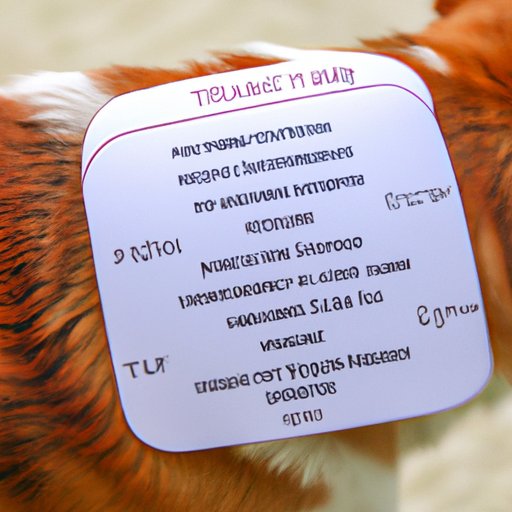Introduction
Skin tags are small, non-cancerous growths on the skin that often appear in areas where there is friction or rubbing. They are extremely common in humans and can be found in other animals as well, including dogs. In this article, we will explore what skin tags are, their causes and treatments in dogs, and how to safely care for a dog that has skin tags.
Exploring the Causes and Treatments of Skin Tags in Dogs
Skin tags are caused by a combination of genetics and environmental factors. In dogs, they are typically found in areas where there is excessive rubbing or friction, such as the neck and belly. Other potential causes include hormonal imbalances, obesity, and certain skin conditions such as allergies or parasites.
Treatment options for skin tags in dogs depend on the size, location, and severity of the growths. If the skin tags are small and not causing any discomfort to the dog, it may be possible to simply leave them alone. However, if the skin tags are large or bothersome, a veterinarian may recommend surgical removal. In some cases, medications such as corticosteroids may be used to reduce inflammation and discomfort associated with skin tags.

How to Tell if Your Dog Has Skin Tags and What to Do About Them
If you suspect that your dog has skin tags, it is important to take them to a veterinarian for an examination. The vet will be able to determine whether or not the growths are indeed skin tags and discuss treatment options. In most cases, skin tags are harmless and do not require any treatment; however, they can sometimes become inflamed or irritated, so it is important to keep an eye on them.
If the skin tags are causing discomfort to your dog, your veterinarian may recommend removing them. This can be done surgically or with cryotherapy (freezing). Your vet will be able to advise you on the best course of action for your pet.

The Safety of Removing Skin Tags from Dogs
Removing skin tags from dogs is generally considered safe, but there are some risks involved. There is a risk of infection, scarring, and irritation at the site of the surgery or cryotherapy. Additionally, the anesthesia used during the procedure carries its own risks, such as respiratory or cardiac complications. It is important to discuss all of these risks with your veterinarian before proceeding with any type of treatment.
It is also important to note that some skin tags can recur after removal, so it is important to monitor the area closely. If the skin tags reappear, you should take your dog back to the veterinarian for further evaluation.
Understanding the Risk Factors for Skin Tags in Dogs
There are several risk factors that can increase a dog’s chances of developing skin tags. These include age, breed, gender, and overall health. Older dogs, female dogs, and overweight dogs are more likely to develop skin tags than younger, male, and healthy dogs. Additionally, certain breeds, such as pugs and bulldogs, are more prone to skin tags due to their anatomy.
In addition to the above risk factors, skin tags can also be caused by certain lifestyle factors. For example, a lack of grooming can lead to skin irritation and increased friction, which can contribute to the development of skin tags. Additionally, dogs who are exposed to toxins or irritants, such as cigarette smoke and cleaning products, may be more likely to develop skin tags.
The best way to prevent skin tags in dogs is to maintain a healthy lifestyle and provide regular grooming. Keeping your dog’s coat clean and free of tangles can help reduce skin irritation and friction, which can lead to the development of skin tags.

A Comprehensive Guide to Caring for Dogs with Skin Tags
Caring for a dog with skin tags requires a few extra steps. It is important to keep the area clean and dry to reduce the risk of infection. Additionally, you should avoid scrubbing or brushing the skin tags, as this can cause irritation and further spread of the growths. You should also use a mild shampoo to clean the area, as harsh shampoos can be too drying.
When it comes to diet and nutrition, dogs with skin tags should eat a balanced diet that includes lean proteins, fresh fruits and vegetables, and complex carbohydrates. It is also important to ensure that your dog is getting enough exercise and activity, as this can help keep their weight under control, which can help reduce the risk of skin tags.
Finally, it is important to keep your dog’s skin tags trimmed and groomed. Regularly trimming the fur around the skin tags can help reduce the risk of infection and irritation. Additionally, it is important to regularly inspect the skin tags for signs of infection, such as redness, swelling, or discharge.
Conclusion
Skin tags are a common skin condition that can affect both humans and animals. While they are generally harmless, it is important to keep an eye on them and consult a veterinarian if you suspect your dog has skin tags. Knowing the causes, treatments, and safety of removing skin tags in dogs, as well as how to tell if your dog has skin tags and how to best care for them, is essential for keeping your pet healthy and happy.
By following the advice outlined in this article, you can help ensure that your dog stays comfortable and healthy, even if they have skin tags. Remember, skin tags are usually harmless, but it is always best to check with your veterinarian if you have any concerns.


